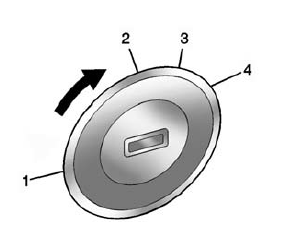Chevrolet Spark Owners Manual: Ignition Positions

The ignition switch has four different positions.
The uplevel key must be fully extended to start the vehicle.
To shift out of P (Park), the ignition must be in ON/RUN and the regular brake pedal applied.
1 (STOPPING THE ENGINE/LOCK/ OFF): When the vehicle is stopped, turn the ignition switch to LOCK/ OFF to turn the engine off.
This position locks the steering wheel, ignition, and transmission.
The ignition switch can bind in the LOCK/OFF position with the wheels turned off center. If this happens, move the steering wheel from right to left while turning the key to ACC/ ACCESSORY. If this does not work, then the vehicle needs service.
Do not turn the engine off when the vehicle is moving. This will cause a loss of power assist in the brake and steering systems and disable the airbags.
If the vehicle must be shut off in an emergency:
- Brake using a firm and steady pressure. Do not pump the brakes repeatedly. This may deplete power assist, requiring increased brake pedal force.
- Shift the vehicle to N (Neutral).
This can be done while the vehicle is moving. After shifting to N (Neutral), firmly apply the brakes and steer the vehicle to a safe location.
- Come to a complete stop. Shift to P (Park) with an automatic transmission, or Neutral with a manual transmission. Turn the ignition to LOCK/OFF.
- Set the parking brake. See Parking Brake on page 9-26.
Warning
Turning off the vehicle while moving may cause loss of power assist in the brake and steering systems and disable the airbags.
While driving, only shut the vehicle off in an emergency.
If the vehicle cannot be pulled over, and must be shut off while driving, turn the ignition to ACC/ ACCESSORY.
Caution
Using a tool to force the key to turn in the ignition could cause damage to the switch or break the key. Use the correct key, make sure it is all the way in, and turn it only with your hand. If the key cannot be turned by hand, see your dealer.
2 (ACC/ACCESSORY): This is the position in which you can operate things like the radio and the windshield wipers when the engine is off.
3 (ON/RUN): This position can be used to operate the electrical accessories and to display some instrument cluster warning and indicator lights. This position can also be used for service and diagnostics, and to verify the proper operation of the malfunction indicator lamp as may be required for emission inspection purposes.
The switch stays in this position when the engine is running.
If you leave the key in the ACC/ ACCESSORY or ON/RUN position with the engine off, the battery could be drained. You may not be able to start the vehicle if the battery is allowed to drain for an extended period of time.
4 (START): This is the position that starts the engine. When the engine starts, release the key. The ignition switch returns to ON/RUN for driving.
A warning tone will sound when the driver door is opened, the ignition is in ACC/ACCESSORY or LOCK/ OFF, and the key is in the ignition.
If the ignition becomes difficult to turn with the uplevel key, see Keys on page 2-1.
 New Vehicle Break-In
New Vehicle Break-In
Caution
The vehicle does not need an elaborate break-in. But it will perform
better in the long run if you follow these guidelines:
Do not drive at any one constant speed, fast or slow, for
...
 Starting the Engine
Starting the Engine
Automatic Transmission
Move the shift lever to P (Park) or N (Neutral). The engine will not start in
any other position. To restart the engine when the vehicle is already moving, use
N (Neutral) ...
Other materials:
Tire Pressure Monitor Operation
This vehicle may have a Tire Pressure Monitor System (TPMS).
The TPMS is designed to warn the driver when a low tire pressure condition exists.
TPMS sensors are mounted onto each tire and wheel assembly, excluding the spare
tire and wheel assembly. The TPMS sensors monitor the air pressure in t ...
High/Low-Beam Headlamp
Connector Retaining Tab
Connector Release
Headlamp Bulb
To replace a headlamp bulb:
Open the hood. See Hood on page 10-5.
Remove the connector retaining tab (1).
Disconnect the wiring harness connector from the bulb (3) by pressing the
connector release (2) and pulling strai ...
Brakes
Disc brake pads have built-in wear indicators that make a high-pitched warning
sound when the brake pads are worn and new pads are needed.
The sound can come and go or be heard all the time when the vehicle is moving,
except when applying the brake pedal firmly.
Warning
The brake wear warning ...
